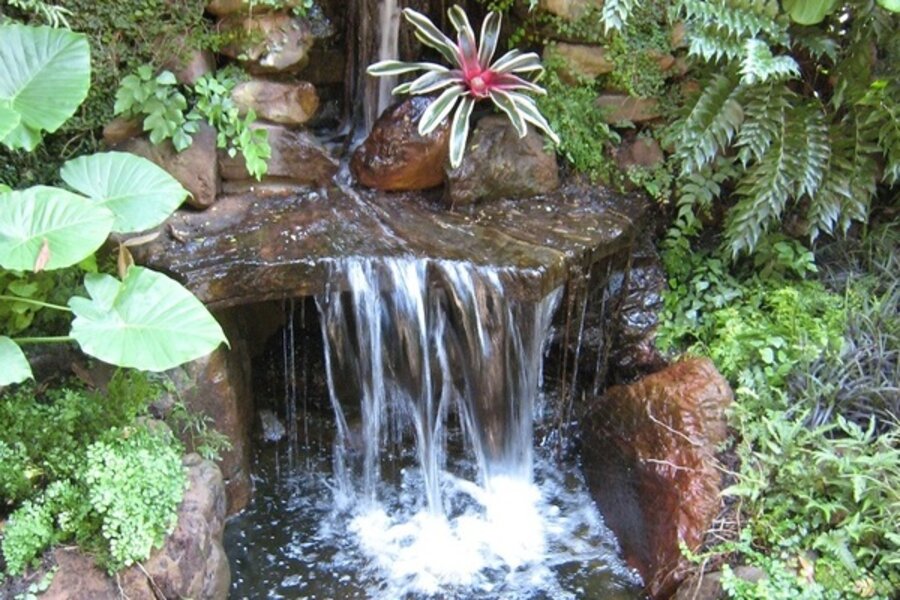Planning a water garden is worth it
Loading...
Time for garden dreaming. My plans may, or may not, come to fruition next summer, but now, when there’s very little I can do outside, I live large in my mind.
And most Big Ideas involve water. My thoughts down these twisting pathways always go from simple to complex. The decision-making process gets right to the heart of how to handle water, the most dynamic garden element.
This particular story starts way up in the air.
Just recently, we had to replace a skylight — a round bubble-shaped five-foot-diameter dome. After 16 years, the sealing around the edges of the circle had failed and rainwater was collecting between the three plexiglas layers.
But I didn’t want those perfectly good half-rounds of sun-resistant plastic trundled off to the landfill.
So what am I going to do with them? My imagination starts running down the path: What if?…What if?…What if I dug out three round holes in the lawn, turned the domes upside down and sank a plexi saucer into each one? I could fill them with river rock and maybe an inch of water on top. A row of three round reflecting pools, shining up to the sun. Neat.
But wait, there’s more. Already, I see my three sparkling water circles turning green. How do I keep the water fresh?
I add a narrow canal between each circle. A pump at the last pool would pipe the water to the top one, where it would filter up through the rocks, overflow the saucer into the runnel, and into the next pool, and then the next. Three round pools joined by a narrow rock-lined canal. Neater.
But now I’m thinking about the pipes. Piping involves discreetly piercing the plexi to get the water pumped out of the last one and into the first. Now we’re complicating things. Pipes, ditches, holes that never leak, and electricity to run the pump. Hmmmm. . . .not reat.
Why does planning for water have to be so hard?
The dynamic scale
One of my favorite Oregon landscape architects — Brad Stangeland — once answered this question for me in terms of design dynamics.
We were standing in a home garden, next to a naturalistic stream that his firm had created. The gurgling watercourse followed a pathway for visitors from the parking area, through a gate, and down to the home’s entrance court.
We were discussing water maintenance in this garden. “Well, of course it’s a regular job,” Brad said. “Everything in a garden is dynamic. The more dynamic it is, the more attention it needs. And water is the most dynamic of all.”
Dynamics vs. payback
If we measure our garden-design choices by this scale, hardscape would be at the bottom. Once it’s installed, it sits there, doing a practical job, but not particularly engaging us. Obviously, within this category, there are still levels of complication. Solid concrete sidewalks require less upkeep than gravel paths. Stone decks need less work than wood.
Up the scale, trees and shrubs are more dynamic than hardscape, but after the initial planting, there’s not a lot to do regularly. They give back color, form, and shade — possibly fruit.
Perennials are further up the chart — think of how many times we clip, deadhead, and divide —a nd there’s more payoff in ever-changing flowers, foliage, and a huge variety of favorite choices.
Vegetables are higher yet, but it’s worth it for the beauty and tasty table treats.
And then there’s water. My simple reflecting pools got complicated fast. The payoff is how enormously attractive it is — life-giving water has the ability to draw us in, to soothe or enliven.
Water is worth it. But attention must be paid. Even when I’m gardening in my mind.
-----
Mary-Kate Mackey blogs regularly about water in the garden for Diggin' It. She is co-author of “Sunset’s Secret Gardens — 153 Design Tips from the Pros” and contributor to the “Sunset Western Garden Book,” writes a monthly column for the Hartley Greenhouse webpage and numerous articles for Fine Gardening, Sunset, and other magazines. She teaches at the University of Oregon’s School of Journalism & Communication. To read more by Mary-Kate, click here.






